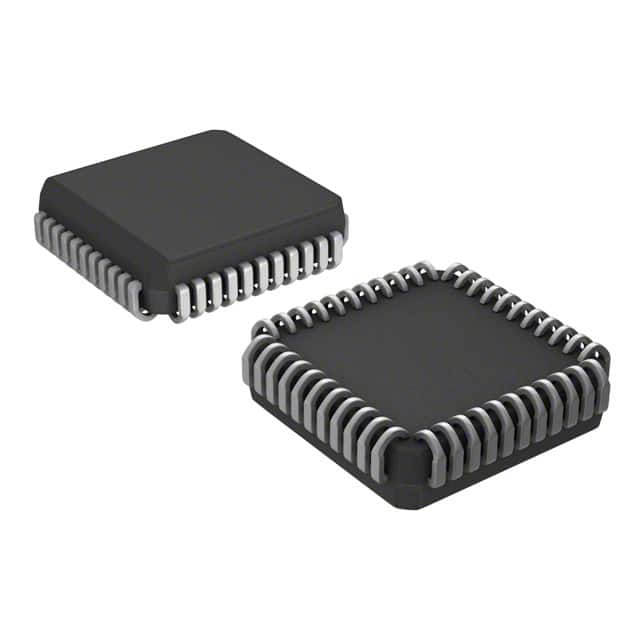EPM3032ALC44-10
Product Overview
Category
EPM3032ALC44-10 belongs to the category of programmable logic devices (PLDs).
Use
This device is commonly used in digital circuit design and implementation. It provides a flexible and customizable solution for various applications.
Characteristics
- Programmable: The EPM3032ALC44-10 can be programmed to perform specific functions based on user requirements.
- High Integration: It offers a high level of integration, allowing multiple logic functions to be implemented within a single device.
- Versatile: This PLD supports a wide range of applications due to its programmability.
- Compact Package: The EPM3032ALC44-10 comes in a compact 44-pin package, making it suitable for space-constrained designs.
- Low Power Consumption: It operates at low power levels, making it energy-efficient.
Package and Quantity
The EPM3032ALC44-10 is packaged in a 44-pin leaded chip carrier (LCC) package. It is typically sold individually or in small quantities.
Specifications
- Device Type: Programmable Logic Device (PLD)
- Package Type: 44-pin LCC
- Operating Voltage: 3.3V
- Speed Grade: 10
- Maximum Number of User I/Os: 32
- Maximum Number of Macrocells: 32
- Maximum Frequency: 100 MHz
- Programmable Logic Blocks: Yes
- Flip-Flops: Yes
- Look-Up Tables: Yes
- JTAG Support: Yes
Pin Configuration
The detailed pin configuration of the EPM3032ALC44-10 is as follows:
Pin 1: GND
Pin 2: IO_0
Pin 3: IO_1
...
Pin 43: VCC
Pin 44: GND
Functional Features
- Programmability: The EPM3032ALC44-10 can be programmed using hardware description languages (HDL) or design software to implement desired logic functions.
- High Integration: It offers a sufficient number of macrocells and I/O pins for complex digital circuit designs.
- Fast Operation: With a maximum frequency of 100 MHz, it can handle high-speed applications.
- JTAG Support: The device supports Joint Test Action Group (JTAG) interface for programming and debugging.
Advantages and Disadvantages
Advantages
- Flexibility: The programmable nature of the EPM3032ALC44-10 allows for easy modification and adaptation to changing requirements.
- Cost-Effective: By eliminating the need for custom-designed integrated circuits, this PLD reduces development costs.
- Time-Saving: The ability to reprogram the device saves time compared to designing and fabricating new hardware.
Disadvantages
- Limited Complexity: While suitable for many applications, the EPM3032ALC44-10 may not have enough resources for highly complex designs.
- Learning Curve: Working with programmable logic devices requires knowledge of HDLs and design tools, which may require additional learning.
Working Principles
The EPM3032ALC44-10 operates based on the principles of programmable logic. It consists of configurable logic blocks (CLBs), look-up tables (LUTs), flip-flops, and interconnects. The user programs the device by specifying the desired logic functions using HDLs or design software. The programmed configuration is then loaded into the PLD, allowing it to perform the specified operations.
Detailed Application Field Plans
The EPM3032ALC44-10 finds applications in various fields, including: 1. Industrial Automation: Used for control systems, monitoring, and data acquisition. 2. Telecommunications: Employed in network equipment, signal processing, and protocol implementation. 3. Consumer Electronics: Integrated into devices such as gaming consoles, set-top boxes, and multimedia systems. 4. Automotive: Utilized for engine control units, driver assistance systems, and infotainment systems. 5. Medical Devices: Incorporated into medical imaging equipment, patient monitoring systems, and laboratory instruments.
Alternative Models
For those seeking alternatives to the EPM3032ALC44-10, the following models offer similar functionality: 1. EPM3064ATC100-10: 64 macrocells, 100 MHz maximum frequency, 100-pin TQFP package. 2. XC9536XL-10VQG44C: 36 macrocells, 10 ns propagation delay, 44-pin VQFP package. 3. ATF1508AS-10AU100: 1500 usable gates, 10 ns maximum delay, 100-pin TQFP package.
These alternative models provide options with varying capacities and package types, allowing users to choose the most suitable PLD for their specific requirements.
기술 솔루션에 EPM3032ALC44-10 적용과 관련된 10가지 일반적인 질문과 답변을 나열하세요.
Sure! Here are 10 common questions and answers related to the application of EPM3032ALC44-10 in technical solutions:
Q: What is EPM3032ALC44-10? A: EPM3032ALC44-10 is a specific model of programmable logic device (PLD) manufactured by Altera.
Q: What is the purpose of EPM3032ALC44-10? A: EPM3032ALC44-10 is designed to provide digital logic functions and can be programmed to perform various tasks in electronic systems.
Q: What are some typical applications of EPM3032ALC44-10? A: EPM3032ALC44-10 is commonly used in applications such as industrial control systems, telecommunications equipment, automotive electronics, and consumer electronics.
Q: How does EPM3032ALC44-10 differ from other PLDs? A: EPM3032ALC44-10 has a specific pin configuration, operating voltage, and speed grade that differentiate it from other PLDs available in the market.
Q: Can EPM3032ALC44-10 be reprogrammed? A: Yes, EPM3032ALC44-10 is a programmable device, which means it can be reprogrammed multiple times to modify its functionality.
Q: What programming languages are supported for EPM3032ALC44-10? A: EPM3032ALC44-10 can be programmed using hardware description languages (HDLs) like VHDL or Verilog.
Q: What tools are required to program EPM3032ALC44-10? A: To program EPM3032ALC44-10, you will need a compatible programmer or development board, along with the necessary software provided by Altera.
Q: What is the maximum number of logic gates that EPM3032ALC44-10 can implement? A: EPM3032ALC44-10 has a capacity of 32 macrocells, which can be used to implement various combinations of logic gates.
Q: Can EPM3032ALC44-10 interface with other components in a system? A: Yes, EPM3032ALC44-10 can interface with other components through its input/output pins, allowing it to communicate and interact with the rest of the system.
Q: Are there any limitations or considerations when using EPM3032ALC44-10? A: Some considerations include power supply requirements, operating temperature range, and ensuring compatibility with other system components. It's important to consult the datasheet and application notes provided by Altera for detailed information.
Please note that the answers provided here are general and may vary depending on specific requirements and implementation details.


